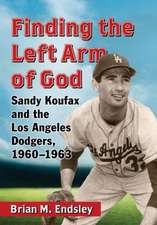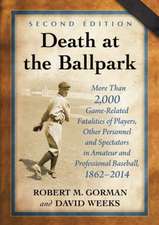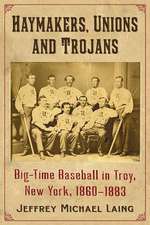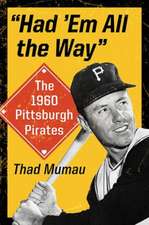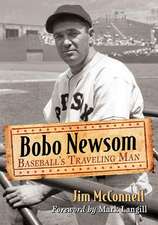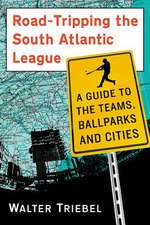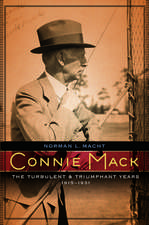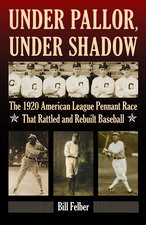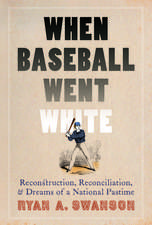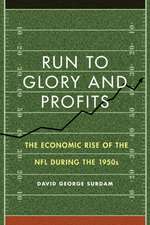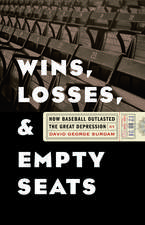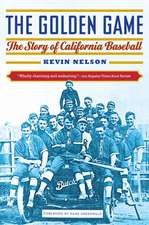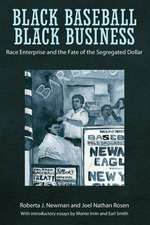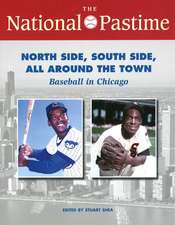The Age of Ruth and Landis: The Economics of Baseball during the Roaring Twenties
Autor David George Surdam, Michael J. Hauperten Limba Engleză Hardback – 31 mai 2018
As the 1919 World Series scandal simmered throughout the 1920 season, tight pennant races drove attendance to new peaks and presaged a decade of general prosperity for baseball. Babe Ruth shattered his own home-run record and, buoyed by a booming economy, professional sports enjoyed what sportswriters termed a “Golden Age of Sports.”
Throughout the tumultuous 1920s, Major League Baseball remained a mixture of competition and cooperation. Teams could improve by player trades, buying Minor League stars, or signing untried youths. Players and owners had their usual contentious relationship, with owners maintaining considerable control over their players. Owners adjusted the game so that the 1920s witnessed a surge in slugging and a diminution in base stealing, and they provided a better ballpark experience by both improving their stadiums and minimizing disruptions by rowdy fans. However, they hesitated to adapt to new technologies such as radio, electrical lighting, and air travel.
The Major Leagues remained an enclave for white people, while African Americans toiled in the newly established Negro Leagues, where salaries and profits were skimpy. By analyzing the economic and financial aspects of Major League Baseball, The Age of Ruth and Landis shows how baseball during the 1920s experienced both strife and prosperity, innovation and conservatism. With figures such as the incomparable Babe Ruth, Kenesaw Mountain Landis, Rogers Hornsby, Ty Cobb, Walter Johnson, Tris Speaker, and Eddie Collins, the decade featured an exciting brand of livelier baseball, new stadiums, and overall stability.
Throughout the tumultuous 1920s, Major League Baseball remained a mixture of competition and cooperation. Teams could improve by player trades, buying Minor League stars, or signing untried youths. Players and owners had their usual contentious relationship, with owners maintaining considerable control over their players. Owners adjusted the game so that the 1920s witnessed a surge in slugging and a diminution in base stealing, and they provided a better ballpark experience by both improving their stadiums and minimizing disruptions by rowdy fans. However, they hesitated to adapt to new technologies such as radio, electrical lighting, and air travel.
The Major Leagues remained an enclave for white people, while African Americans toiled in the newly established Negro Leagues, where salaries and profits were skimpy. By analyzing the economic and financial aspects of Major League Baseball, The Age of Ruth and Landis shows how baseball during the 1920s experienced both strife and prosperity, innovation and conservatism. With figures such as the incomparable Babe Ruth, Kenesaw Mountain Landis, Rogers Hornsby, Ty Cobb, Walter Johnson, Tris Speaker, and Eddie Collins, the decade featured an exciting brand of livelier baseball, new stadiums, and overall stability.
Preț: 336.63 lei
Nou
Puncte Express: 505
Preț estimativ în valută:
64.42€ • 66.56$ • 53.59£
64.42€ • 66.56$ • 53.59£
Carte tipărită la comandă
Livrare economică 20 martie-03 aprilie
Preluare comenzi: 021 569.72.76
Specificații
ISBN-13: 9780803296824
ISBN-10: 0803296827
Pagini: 420
Ilustrații: 25 tables, 2 appendixes, index
Dimensiuni: 152 x 229 x 36 mm
Greutate: 0.77 kg
Editura: Nebraska
Colecția University of Nebraska Press
Locul publicării:United States
ISBN-10: 0803296827
Pagini: 420
Ilustrații: 25 tables, 2 appendixes, index
Dimensiuni: 152 x 229 x 36 mm
Greutate: 0.77 kg
Editura: Nebraska
Colecția University of Nebraska Press
Locul publicării:United States
Notă biografică
David George Surdam is a professor of economics and the David W. Wilson Business Ethics Fellow at the University of Northern Iowa. He is the author of several books, including Run to Glory and Profits: The Economic Rise of the NFL during the 1950s (Nebraska, 2013) and Wins, Losses, and Empty Seats: How Baseball Outlasted the Great Depression (Nebraska, 2011). Michael J. Haupert is a professor of economics at the University of Wisconsin–La Crosse.
Cuprins
List of Tables
Acknowledgments
Introduction
1. Baseball’s Interminable Wars
2. The Rise of Judge Kenesaw Mountain Landis
3. Baseball’s Longstanding Gambling Problem
4. The Financial Side of the Game
5. Getting Fans to the Ballpark
6. Trying to Make the Game More Popular
7. Not a Perfect Game
8. The Stars Are Realigned
9. Competitive Balance and Its Discontents
10. Owners versus Players
11. Highly Paid but Exploited Players
12. Hang On, the Minor Leagues’ Bumpy Ride
13. Baseball and Ethnic Diversity
14. Hilldale and the Negro Leagues in the 1920s
Epilogue: The Roaring Twenties and Major League Baseball
Appendix 1: New York Yankees Financial Records
Appendix 2: Salary Data Sources
Notes
Bibliography
Index
Acknowledgments
Introduction
1. Baseball’s Interminable Wars
2. The Rise of Judge Kenesaw Mountain Landis
3. Baseball’s Longstanding Gambling Problem
4. The Financial Side of the Game
5. Getting Fans to the Ballpark
6. Trying to Make the Game More Popular
7. Not a Perfect Game
8. The Stars Are Realigned
9. Competitive Balance and Its Discontents
10. Owners versus Players
11. Highly Paid but Exploited Players
12. Hang On, the Minor Leagues’ Bumpy Ride
13. Baseball and Ethnic Diversity
14. Hilldale and the Negro Leagues in the 1920s
Epilogue: The Roaring Twenties and Major League Baseball
Appendix 1: New York Yankees Financial Records
Appendix 2: Salary Data Sources
Notes
Bibliography
Index
Recenzii
"In this book, one can almost hear the metallic clang that represents net, gross, and the bottom line."—Bob D'Angelo, Sport in American History
"The characters alone make this book a must read for baseball enthusiasts."—T. M. Marini, Choice
"A thoroughly researched account of a pivotal period in Organized Baseball, The Age of Ruth and Landis illuminates the driving forces behind changes that occurred then. Authors Surdam and Haupert, both professors of economics, delve into the fascinating, and sometimes surprising history of an era, combining human interest with hard data to explain the complexity of the sport's evolution."—Joan M. Thomas, Inside Game
"Surdam and Haupert make a worthy contribution to our understanding of this pivotal era of the game's economic history."—John Charles Bradbury, EH.net
"By analyzing the economic and financial aspects of Major League Baseball, The Age of Ruth and Landis shows how baseball during the 1920s experienced both strife and prosperity, innovation and conservatism."—Jason Schott, Brooklyn Digest
"The well-documented book is not about the game as it was played on the field or the greats playing it, but instead focuses on the business of baseball, delving into the conflicts between cities, teams, players, and owners, and the economic success of the 16 teams that comprised the two major leagues."—Andrew Elias, Ft. Myers Magazine
"Though it can be argued that the big money has adversely affected professional sports, the profit motive has always been a big factor in the history of baseball. This account with slugger Ruth and baseball commissioner Kenesaw Mountain Landis as the two headliners wisely follows the money."—Robert Birnbaum, Our Man in Boston blog
"This book fills a need. It deserves a following. It brings the sensibilities of economic analysis, gently presented, to an era in the game’s history the study of which will never be exhausted."—Steven P. Gietschier, NINE
“Two of the sport’s leading economic historians provide a perceptive, multifaceted exploration of baseball’s economics and governance in the decade after the National Commission’s collapse. And, like the Sultan of Swat, Surdam and Haupert touch all the bases.”—Trey Strecker, editor of NINE: A Journal of Baseball History and Culture
“The financial information on a Negro League team offers important new insights into the game’s economics outside Major League Baseball. An added bonus [is] the great wealth of informative, valuable tables. . . . This book [is] essential for anyone researching baseball in the 1920s. It should also appeal to the larger group of scholars and readers interested in the history of the business of baseball.”—Daniel Levitt, coauthor of In Pursuit of Pennants: Baseball Operations from Deadball to Moneyball

